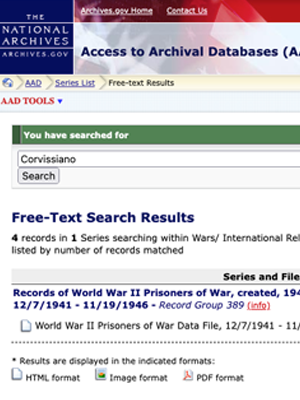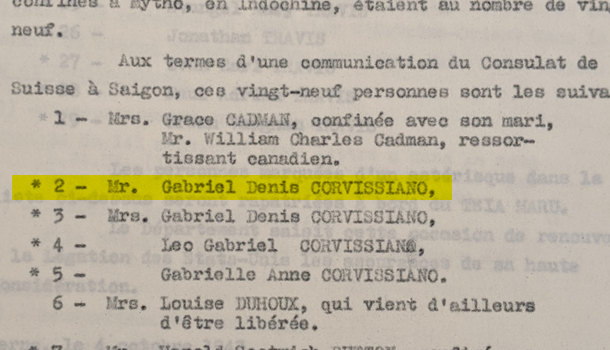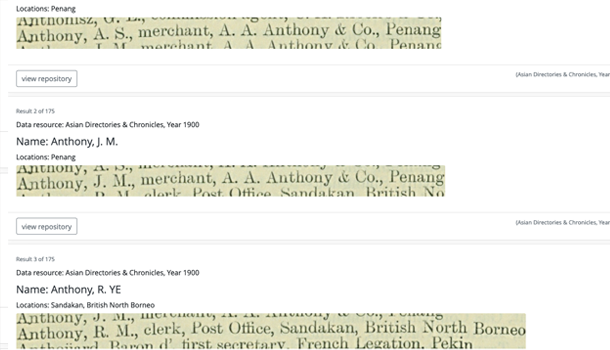Comparing heterogeneous archival sources. DPCL has gathered archival sources internationally relating to European citizens resident in Indochina during World War II, including material recently released by the French Government, and analyzed them using novel digital methods.
DPCL has gathered archival sources relating to European citizens resident in Indochina during World War II, including material recently released by the French Government, and analyzed them to produce searchable person instance datasets. The case study shows how individuals can be traced using such empirical data, leading to insights about internment policies in this territory.
A wave of repression and internment directed against citizens of allied nations in Indochina commenced at the beginning of 1941. The Japanese had built a formidable military presence in the territory following troubled negotiations with French authorities during the Summer of 1940. Following the assault by the Wehrmacht in May 1940 and subsequent defeat of France in Europe six weeks later, Japan increasingly sought concessions.
After the attack on Pearl Harbor in December 1941, Japanese pressure on formerly neutral French Indochina increased still further and Japanese espionage manifested in measures against citizens of states then at war with the Empire of Japan. The French authorities in Indochina reluctantly acquiesced, and allied civilians were interned in the civilian internment camp in Mytho, approximately 70 kilometers outside Saigon, in a decommissioned military barracks. The treatment of inmates, however, was acceptable compared to other Civilian Assembly Centers in Asia—primarily because the French authorities sought to avoid provocation of the Allies, and they presented themselves as a neutral actor.
Approximately 188 American, British and Dutch citizens can be traced in Indochina immediately before these measures, but of those 28 were placed under house arrest and 48 under surveillance while 50 citizens of Allied states were interned at Mytho (4). Archival material from the Mytho internment camp concerning the U.S. citizens was compiled by the Swiss Consul in Saigon, Hans Hirsbrunner, as “Les ressortissants américains confinés à Mytho” and was sent to the American delegation in early October 1943.
We can demonstrate the utility of a new data-set-driven methodology by comparing persons appearing in the NARA list of civilian PoWs with Hirsbrunner’s list of internees at Mytho.

Gabriel Corvissiano appears in the Mytho list of internees and is also identified in the PoW records of the U.S. National Archive

Corvissiano and family members appear in records compiled by the Swiss Consul in Saigon

Charles Anthony, Corvissiano's business partner, discovered in the Asia Directories
A Swiss-born American, Gabriel Denis Corvissiano was interned at Mytho and appears in Hirsbrunner's documentation and also in American civilian internee records at NARA (National Archives and Records Administration) in the U.S., which were based on Red Cross reports from the region and have been enriched and made available as JSON datasets by an existing Europe Institute Basel project (https://doi.org/10.5281/zenodo.3565392).
DPCL’s analysis of Hirsbrunner's documentation confirms that Corvissiano was present at Mytho, together with his wife and children Leo and Gabrielle. Further research in French archives offered more insights into this individual and sheds light on the complicated relationship between French, Japanese and Allied citizens in Indochina. Gabriel Corvissiano was arrested, like most of his compatriots, soon after Japan entered World War II. However, he was treated differently because of his commercial activities: specifically, he was a partner of the French citizen Charles Edouard Anthony in the operation of a phosphor mining concession.
Corvissiano's and Anthony's enterprise was in an economic sector of strategic interest to the Japanese, but since the French authorities sought to curb foreign influence in the economic sphere of the colony, the Japanese were only permitted to operate in cooperation with a French citizen. Japanese intelligence recognized the opportunity presented by Anthony’s circumstances, leading to the release of Corvissiano from detention on commercial grounds. However, the threat of re-internment remained: Corvissiano was reminded by the police of the ‘benevolence’ of Japanese officials, intending to persuade him to relinquish his commercial interest and make way for a Japanese partner in the business. He conceded his share of the concession in August 1942 and he and his family were soon after repatriated to Lourenço Marques.
Charles Anthony can also be traced using the Asia Directories and Chronicles listings, which have been digitized and analyzed in another sub-project of The Divisive Power of Citizenship. We find 8 appearances of an Anthony, C. E. in the Directories, in Haiphong between 1926 and 1939. The person instances, which (as well as appearances of others by the same surname) can be viewed interactively at https://asia-directories.org, list the occupation of this Anthony consistently as Commercial Manager or Commercial Director and, additionally, return either Société des Verrieries des d'Extreme-Orient or Société des d'Extreme-Orient or Société Francaise des Verreries d'Indo-Chine as employer. These results are inadequate alone to establish an unequivocal Charles Anthony person entity, however they are already strongly supportive of the residence of a single individual using this name in Haiphong between 1926 and 1941, prior to his association with Corvissiano.
Reconstructing this narrative via a thread of historic person instance datasets greatly increases the rate at which such hypotheses can be tested, reducing recourse to physical archives, and reveals additional significant sources. In this example it has provided insight interactively into the politics of internment in Indochina perpetrated by the French authorities, as well as the challenges faced by Gabriel Corvissiano. This would have very laborious indeed to achieve using conventional methods. Corvissiano seems to be an exception: currently we can identify no other US citizen able to pursue his profession after internment had begun and subsequently repatriated. Corvissiano’s position gave him freedoms which no other US-American enjoyed. For his part Charles Edouard Anthony, probably grasped opportunities that political realities offered for his own benefit. On one hand the overwhelming Japanese military presence and increasing isolation of Indochina meant that Japan represented the only practical market for Anthony’s business. On the other hand, Japanese citizens were only allowed to participate in markets in partnership with French businesses. Anthony realized that continued collaboration with a partner from an Allied nation was untenable, and precipitated Corvissiano’s departure.